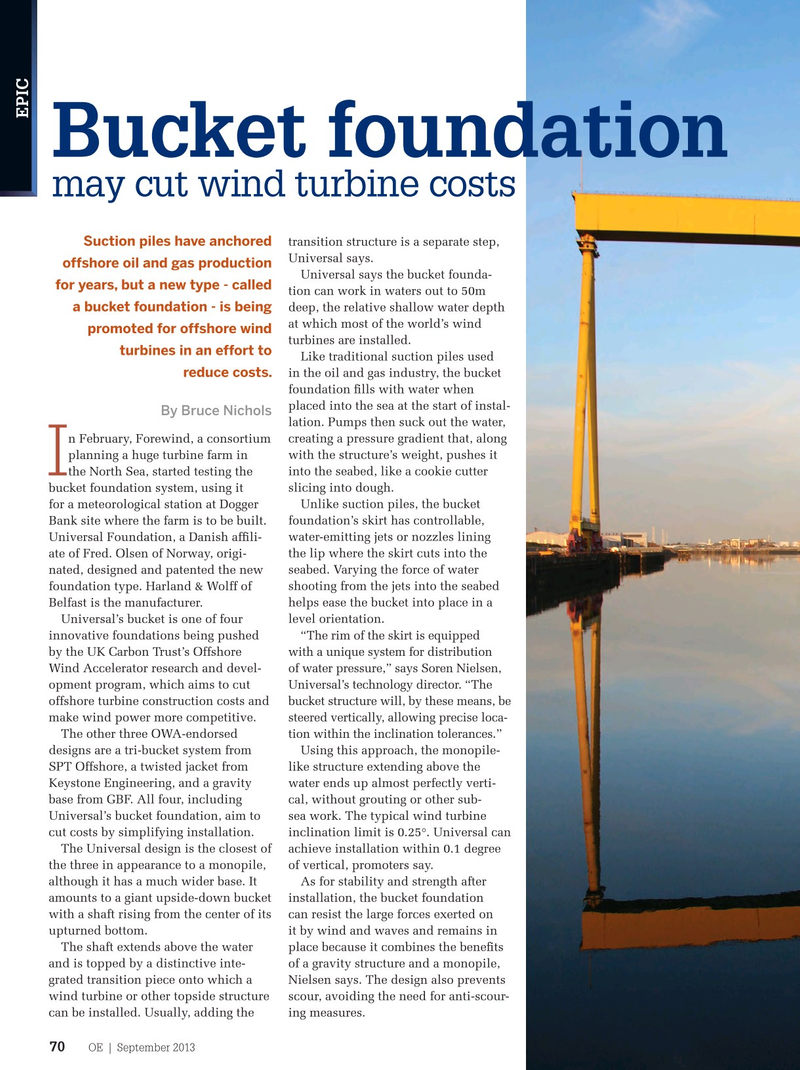
Page 68: of Offshore Engineer Magazine (Sep/Oct 2013)
Read this page in Pdf, Flash or Html5 edition of Sep/Oct 2013 Offshore Engineer Magazine
EPIC
Bucket foundation may cut wind turbine costs transition structure is a separate step,
Suction piles have anchored
Universal says.
offshore oil and gas production
Universal says the bucket founda- for years, but a new type - called tion can work in waters out to 50m deep, the relative shallow water depth a bucket foundation - is being at which most of the world’s wind promoted for offshore wind turbines are installed.
turbines in an effort to
Like traditional suction piles used in the oil and gas industry, the bucket reduce costs.
foundation flls with water when placed into the sea at the start of instal-
By Bruce Nichols lation. Pumps then suck out the water, n February, Forewind, a consortium creating a pressure gradient that, along planning a huge turbine farm in with the structure’s weight, pushes it the North Sea, started testing the into the seabed, like a cookie cutter
I bucket foundation system, using it slicing into dough. for a meteorological station at Dogger Unlike suction piles, the bucket
Bank site where the farm is to be built. foundation’s skirt has controllable,
Universal Foundation, a Danish affli- water-emitting jets or nozzles lining ate of Fred. Olsen of Norway, origi- the lip where the skirt cuts into the nated, designed and patented the new seabed. Varying the force of water foundation type. Harland & Wolff of shooting from the jets into the seabed
Belfast is the manufacturer. helps ease the bucket into place in a
Universal’s bucket is one of four level orientation.
innovative foundations being pushed “The rim of the skirt is equipped by the UK Carbon Trust’s Offshore with a unique system for distribution
Wind Accelerator research and devel- of water pressure,” says Soren Nielsen, opment program, which aims to cut
Universal’s technology director. “The offshore turbine construction costs and bucket structure will, by these means, be make wind power more competitive.
steered vertically, allowing precise loca-
The other three OWA-endorsed tion within the inclination tolerances.” designs are a tri-bucket system from Using this approach, the monopile-
SPT Offshore, a twisted jacket from like structure extending above the
Keystone Engineering, and a gravity water ends up almost perfectly verti- base from GBF. All four, including cal, without grouting or other sub-
Universal’s bucket foundation, aim to sea work. The typical wind turbine cut costs by simplifying installation. inclination limit is 0.25°. Universal can
The Universal design is the closest of achieve installation within 0.1 degree the three in appearance to a monopile, of vertical, promoters say.
although it has a much wider base. It As for stability and strength after amounts to a giant upside-down bucket installation, the bucket foundation with a shaft rising from the center of its can resist the large forces exerted on upturned bottom. it by wind and waves and remains in
The shaft extends above the water place because it combines the benefts and is topped by a distinctive inte- of a gravity structure and a monopile, grated transition piece onto which a Nielsen says. The design also prevents wind turbine or other topside structure scour, avoiding the need for anti-scour- can be installed. Usually, adding the ing measures.
OE | September 2013 oedigital.com 70 070_OE0913_EPIC4 forewind.indd 70 8/18/13 8:34 PM

 67
67

 69
69